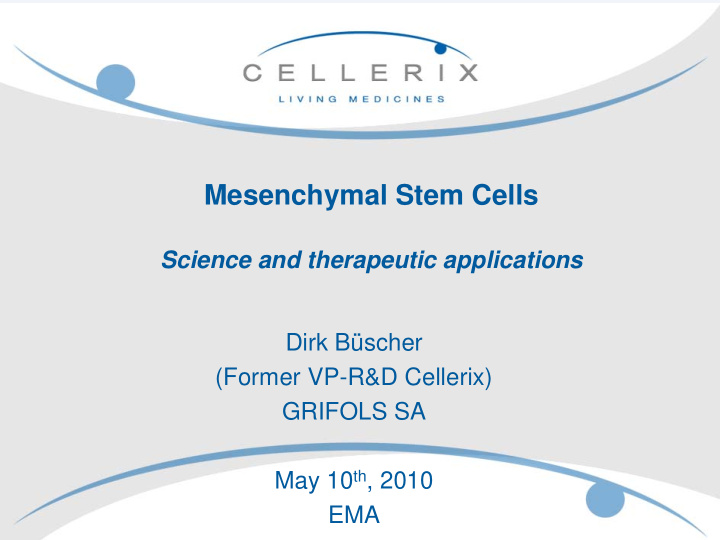



Mesenchymal Stem Cells Science and therapeutic applications Dirk Büscher (Former VP-R&D Cellerix) GRIFOLS SA May 10 th , 2010 1 EMA
Discovery and Definition of Discovery and Definition of Mesenchymal Mesenchymal Stem Cells tem Cells • MSC must be plastic-adherent if maintained in standard culture conditions • MSC must express CD105, CD73 and CD90; lack expression of hematopoietic markers such as CD45, CD34, CD14 or CD11b. • MSC must be capable of differentiation to osteoblasts, adipocytes and chondroblasts under differentiating conditions Minimal criteria for defining multipotent mesenchymal stromal cells. The International Society for Cellular Therapy position statement (Dominici et al., 2006) Wikipedia: Mesenchymal stem cells Mesenchymal stem cells (MSCs) are of stromal origin and may differentiate into a variety of tissues. MSCs have been isolated from placenta (2004) , adipose tissue (2001) , lung (2004) , bone marrow (1994) and blood (2001) , Wharton's jelly from the umbilical cord (2001) , and teeth (2000) (perivascular niche of dental pulp and periodontal ligament). MSCs are attractive for clinical therapy due to their ability to differentiate , provide trophic support , and modulate innate immune response . 2
Publications Pubmed: http://www.ncbi.nlm.nih.gov/ (April 2010) • Mesenchymal stem cells: 10774 (1556 reviews) • Mesenchymal stem cells + Differentiation: 6177 (848 reviews) • Mesenchymal stem cells + Secretion: 421 (42 reviews) • Mesenchymal stem cells + Inflammation 301 (73 reviews) • Mesenchymal stem cells + Immune system 919 (152 reviews) • Mesenchymal stem cells + Autoimmune 148 (63 reviews) • Mesenchymal stem cells + Disease 1593 (422 reviews) 3
Clinical trials http://www.clinicaltrials.gov Search term: Mesenchymal stem cells => 102 trials (April 2010) • Secondary Progressive Multiple Sclerosis • Osteonecrosis of the Femoral Head • Graft Rejection and Graft Versus Host Disease • Liver Cirrhosis (injection of progenitor of hepatocyte • Diabetic Foot derived from Mesenchymal stem cell) • Primary Sjögren’s Syndrome • Treatment of Articular Cartilage Defects • Chronic Allograft Nephorpathy • Cardiac Surgery • Type 1 Diabetis • Myocardial Ischemia • Subclinical Rejection (Organ Transplants) • MSCs in AMI (Acute Myocardial Infarction) • Moderate-to-Severe Crohn’s Disease • Parkinson’s Disease • Ischemic Stroke • Osteogenisis Imperfecta • Lupus Nephritis • Oestoarthritis • Sytemic Lupus Erythematosus • Epidermolysis Bullosa • Systemic Sclerosis • Regeneration of Peridontal Tissue • Chronic Critical Limb Ischemia • Intra-Articular Injection Following Meniscectomy • Compex Peri-anal Fistula • Chronic obstructive Pulmonary Disease • Inflammatory Response After Muscle and Skeleton Trauma (IRAMST) 4
Origin and usage Adult stem cells: Multipotent use = differentiation (regeneration) use = immunomodulation use = screening (?) 5
STAINING L2400303 CD3 CD9 eASCs eASCs CD10 CD11B CD13 CD14 CD15 CD16 CD18 CD19 CD28 CD29 CD31 CD34 CD36 CD38 CD44 CD45 CD49a CD49b CD49c CD49d CD49e CD49f CD50 CD51 CD54 CD55 CD56 CD58 CD59 CD61 CD62E CD62L CD62P CD71 CD90 CD95 CD102 CD104 CD105 CD106 CD117 CD133/2 CD166 CD235a HLAI HLAII NGFR 6 D7-FIB b2 microglob.
Differentiation: Mechanism of Action I Differentiation: Mechanism of Action I Fat Neurons Cartilage Skeletal muscle ASC Cardiomyocyte Bone 7
Clonality and stemness Clonal differentiation in ASCs Differentiation after expansion Osteocytes Adipocytes 8
Secretome: Mechanism of Action II Angiogenesis • Inhibition of apoptosis in ischemia • Secretion of trophic factors such as: • IL6, IL11, GM-CSF, WNTs • Secretion of VEGF • Angiogenesis and repair of tissue 9 Iwase et al 2005
Mechanism of Action III A B C Healing Inflammation Delivery of e ASCs/MSCs • Activation of eASC by a cytokine called IFN- γ • Elimination of activated PBLs • Infiltration of lymphocytes (PBLs) in wound area • Abrogation of pro-inflammatory • Expression of an enzyme called IDO by eASCs • Secretion of pro- cytokines • Suppression the proliferation of activated PBLs inflammatory cytokines • Cessation of pain • Suppression of production of inflammatory • Sensation of pain • Repair of tissue signals 10
Mechanism of Action IV APCs CD4 Treg A B Migration Immuno-modulation • Active movement out of a local environment • Migration into secondary lymph organs (bone marrow, connective tissue) • Physical contact with APCs and T/B cells • Entering into the blood stream • Induction of new Treg cells and/or and/or • Entering into the lymph system 11 • Selective expansion of Treg cells
Size does matter 12
Survival of MSCs: Safety and Function Intra-venous 1,E+08 1,E+07 PHC'S 1,E+06 1,E+05 2wk 24wk 32wk Injection 2d 1wk 3wk 4wk 5wk 8wk 12wk 1,E+04 OD 2D 1wk 2wk 3wk 4wk 5wk 8wk 12wk 24wk 32wk WEEKS AFTER INOCULATION Intra-muscular 1,E+08 1,E+07 PHCs 1,E+06 1,E+05 1wk 2wk 3wk 4wk 5wk 8wk 12wk 24wk 32wk Injection 1,E+04 0D 1WK 2WK 3WK 4WK 5WK 8WK 12WK 24 WK 32WK WEEKS AFTER INOCULATION 13 Vilalta et al., 2008
Autologous versus Allogeneic AUTOLOGOUS ALLOGENEIC Pros Pros • No rejection • Universal medicine: Standardized product • Simpler quality control requirements • Medicine ready to use when needed Cons • No patient “biopsies” required: • Single batch production per patient • Simplification of logistics • Several weeks are needed to have the • Patient's benefit product ready to be implanted in the • Reduction of costs patient • Patient “biopsies” required Cons • Difficult logistics • (Theoretical) risk of rejection • High cost of production • Additional regulatory issues (i.e. more quality control needed)
MSCs: Immuno-privileged Other cell types MSCs Surface antigens Surface antigens • High levels of MHC I (HLA-A, B, C) • Low levels of MHC I (HLA-A, B, C) • MHC II: depending on cell type • Lack of MHC II (HLA-DR, DQ, DP) • Co-stimulatory molecules • Lack of co-stimulatory molecules • Depending on cell type • CD40 (TNFR), CD80 (B7-1), CD86 (B7-2) • High levels of CD55 (DAF) and CD59 • CD55 and CD59: depending on cell (Protectin) => protectors of complement type associated lysis Other Factors Other Factors • Lack of IDO induction • Strong IDO induction
THANK YOU FOR YOUR ATTENTION 16
Recommend
More recommend